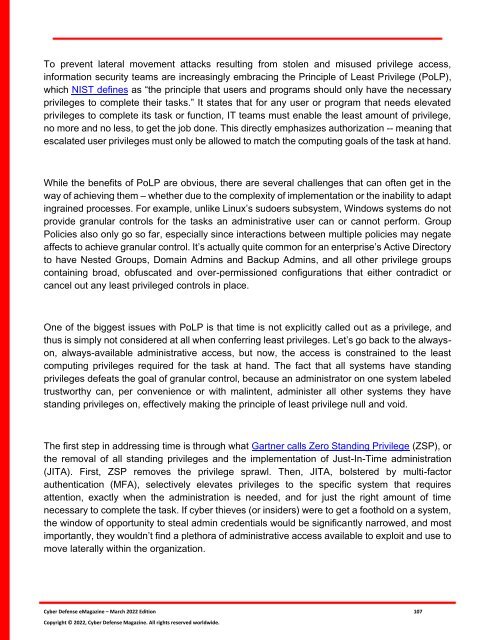Cyber Defense eMagazine March Edition for 2022
The view from the Publisher’s desk is very encouraging, based on celebrating 10 years of growth and success at Cyber Defense Magazine! When our tiny team began our journey at Cyber Defense Media Group (CDMG) together in January 2012, we were happy to help smaller, lesser-known innovators of infosec, get their message out there and Rise Above the noise. Now, after 10 years, we’re even helping multi-billion-dollar companies and governments around the globe with our offices in DC, London, FL, NY and other locations in play, as we continue to scale, thanks to you – our readers, listeners, viewers and media partners. Beyond the magazine, in response to the demands of our markets, the scope of CDMG’s activities has grown into many media endeavors. They now include Cyber Defense Awards; Cyber Defense Conferences; Cyber Defense Professionals (job postings site being revamped); Cyber Defense TV, Radio, and Webinars; and Cyber Defense Ventures (partnering with investors). Please check them out and see how much more CDMG has to offer! Very respectfully and with much appreciation, Gary Miliefsky, Publisher
The view from the Publisher’s desk is very encouraging, based on celebrating 10 years of growth and success at Cyber Defense Magazine! When our tiny team began our journey at Cyber Defense Media Group (CDMG) together in January 2012, we were happy to help smaller, lesser-known innovators of infosec, get their message out there and Rise Above the noise. Now, after 10 years, we’re even helping multi-billion-dollar companies and governments around the globe with our offices in DC, London, FL, NY and other locations in play, as we continue to scale, thanks to you – our readers, listeners, viewers and media partners. Beyond the magazine, in response to the demands of our markets, the scope of CDMG’s activities has grown into many media endeavors. They now include Cyber Defense Awards; Cyber Defense Conferences; Cyber Defense Professionals (job postings site being revamped); Cyber Defense TV, Radio, and Webinars; and Cyber Defense Ventures (partnering with investors).
Please check them out and see how much more CDMG has to offer!
Very respectfully and with much appreciation,
Gary Miliefsky, Publisher
Create successful ePaper yourself
Turn your PDF publications into a flip-book with our unique Google optimized e-Paper software.
To prevent lateral movement attacks resulting from stolen and misused privilege access,<br />
in<strong>for</strong>mation security teams are increasingly embracing the Principle of Least Privilege (PoLP),<br />
which NIST defines as “the principle that users and programs should only have the necessary<br />
privileges to complete their tasks.” It states that <strong>for</strong> any user or program that needs elevated<br />
privileges to complete its task or function, IT teams must enable the least amount of privilege,<br />
no more and no less, to get the job done. This directly emphasizes authorization -- meaning that<br />
escalated user privileges must only be allowed to match the computing goals of the task at hand.<br />
While the benefits of PoLP are obvious, there are several challenges that can often get in the<br />
way of achieving them – whether due to the complexity of implementation or the inability to adapt<br />
ingrained processes. For example, unlike Linux’s sudoers subsystem, Windows systems do not<br />
provide granular controls <strong>for</strong> the tasks an administrative user can or cannot per<strong>for</strong>m. Group<br />
Policies also only go so far, especially since interactions between multiple policies may negate<br />
affects to achieve granular control. It’s actually quite common <strong>for</strong> an enterprise’s Active Directory<br />
to have Nested Groups, Domain Admins and Backup Admins, and all other privilege groups<br />
containing broad, obfuscated and over-permissioned configurations that either contradict or<br />
cancel out any least privileged controls in place.<br />
One of the biggest issues with PoLP is that time is not explicitly called out as a privilege, and<br />
thus is simply not considered at all when conferring least privileges. Let’s go back to the alwayson,<br />
always-available administrative access, but now, the access is constrained to the least<br />
computing privileges required <strong>for</strong> the task at hand. The fact that all systems have standing<br />
privileges defeats the goal of granular control, because an administrator on one system labeled<br />
trustworthy can, per convenience or with malintent, administer all other systems they have<br />
standing privileges on, effectively making the principle of least privilege null and void.<br />
The first step in addressing time is through what Gartner calls Zero Standing Privilege (ZSP), or<br />
the removal of all standing privileges and the implementation of Just-In-Time administration<br />
(JITA). First, ZSP removes the privilege sprawl. Then, JITA, bolstered by multi-factor<br />
authentication (MFA), selectively elevates privileges to the specific system that requires<br />
attention, exactly when the administration is needed, and <strong>for</strong> just the right amount of time<br />
necessary to complete the task. If cyber thieves (or insiders) were to get a foothold on a system,<br />
the window of opportunity to steal admin credentials would be significantly narrowed, and most<br />
importantly, they wouldn’t find a plethora of administrative access available to exploit and use to<br />
move laterally within the organization.<br />
<strong>Cyber</strong> <strong>Defense</strong> <strong>eMagazine</strong> – <strong>March</strong> <strong>2022</strong> <strong>Edition</strong> 107<br />
Copyright © <strong>2022</strong>, <strong>Cyber</strong> <strong>Defense</strong> Magazine. All rights reserved worldwide.


















